
Tên tiếng Anh: Flower Horn Fish
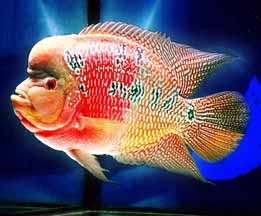
Người ta đã biết nhiều về cá La Hán sống dưới nước (đặc biệt vùng Đông Nam Á) sau những cơn mưa dông trong hai năm qua. Bằng cách thu thập các xung lượng, trên Thế giới người ta biết đến cá này như loại cá đĩa hoặc giống arowana.
Về cơ bản cá La Hán nguồn gốc từ họ Cichlid, mà người ta xếp loại là Cichlasoma, được tìm thấy ở Nam Mỹ. Người ta nghĩ loại lai giống đẹp là họ sau cùng được pha trộn giữa Cichiasoma Trimaculatus, Cichlasoma Festae, Jingang Blood Parrot, v.v… Ngày nay nhiều họ La Hán đẹp là kết quả lai tạo của người chuyên nuôi cá am hiểu và được xuất ra thị trường.
Theo các báo cáo cho biết cá La Hán giống như sự biến thể của một loài cá nào đó. Điều này chỉ có giá trị như là một dự đoán. Thẳng thắn mà nói, La Hán đã trải qua sự lai giống có chọn lọc để ngày nay có được những cá tính của họ Cichlid. Ví dụ, hầu hết những người nuôi cá đang cố gắng tạo ra loại La Hán có đầu gù to hơn, màu sắc sặc sỡ hơn, dấu đen trên mình sậm hơn (lúc này nó tương tự như những chữ Trung Hoa), đuôi và vây cá trông tao nhã hơn và hình dáng to hơn. Không phải kỹ thuật sử dụng hóa học hoặc sinh học để có thể tạo được những đặc điểm của La Hán. Do vậy người ta chưa thể nói La Hán có là do biến thể từ một loài cá nào đó.
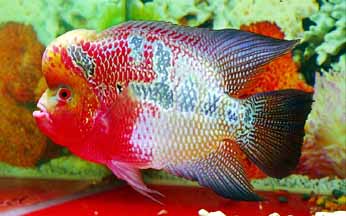
Ngoài ra La Hán là loài cá rất khoẻ mạnh, và có thể tồn tại được trong điều kiện nước không thích hợp với các loài cá thông thường nuôi trong bể. Đây cũng là một trong những lý do mà các loài cá kỳ lạ miền nhiệt đới nhận ra nó. Loài La Hán ở Nam Mỹ họ Cichlid là loài cá mang tính địa phương. Do vậy, bản tính tự nhiên của nó rất hung hăng. Không thể sống chung với loài cùng giống. Vài loài cá khác có thể sống chung với loài La Hán này. Thực chất La Hán muốn giải thoát khỏi sự xâm phạm (sự xâm phạm đó có thể là cây gậy hoặc bàn tay con người). Do đó, nó lý giải cho việc khi ta đưa tay vào cá sẽ cắn tùy thuộc vào kích cỡ của nó.
- Nhận xét và đánh giá
- Bệnh tật và phòng ngừa
- Những bệnh thông thường
- Ứng xử của loài cá và giới tính
- La Hán và phong thủy
- Tạo ra quan hệ xã hội
Theo Flowerfish
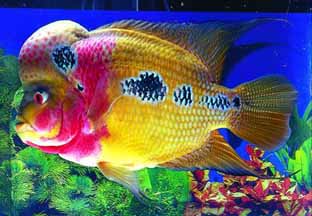
Bài viết dưới đây hướng dẫn căn bản việc bảo quản cá La Hán. Những người nuôi cá kinh nghiệm đều tuân thủ theo. Nhưng cũng có một vài thông tin chưa thích hợp. Nếu bạn có những thắc mắc thì đừng ngại liên hệ với chúng tôi bằng cách nhấp vào đây (click here).
Nhiệt độ
Như hầu hết cá loài cá nhiệt đới, La Hán phát triển ở nhiệt độ khoảng 20 – 30 độ C. Đề nghị nhiệt độ dao động 28 – 31 độ C.
Một trong những tiêu chuẩn quan trọng bảo quản cá là độ pH trong nước. Độ pH đo lường tính axít hoặc tính kềm trong nước. Độ pH từ 0 – 14. La Hán đòi hỏi nước có tính kềm giữa 7.5 – 8. Để duy trì môi trường nước ổn định, cần thay nước 1 tuần 1 lần. Nên cho san hô và sỏi để duy trì độ ổn định của pH. Như những loài cá khác, sự thay đổi đột ngột dẫn đến thay đổi độ pH gây ra thiệt hại cho La Hán. Để phòng ngừa vấn đề này, cần phải kiểm tra định kỳ độ pH.
Nhìn chung La Hán d6ẽ bảo quản. La Hán là loài cá khoẻ mạnh. Nhưng để thấy được những ưu việt của cá (màu sắc, đầu gù và thể trạng nói chung) thì chúng ta nên kết hợp hệ thống lọc hiệu quả. Có khá nhiều hệ thống lọc trên thị trường. Hệ thống lọc nên hội đủ các tiêu chuẩn sau:
Dễ dàng vệ sinh
Động cơ đủ công suất
Lọc bẩn tránh bị nghẹt
Sau cùng là việc thay nước cũng rất quan trọng.
Việc thay nước là việc vặt vãnh đôi khi làm người ta ngại. Để duy trì hồ nước được tốt, cần thay nước định kỳ tối thiểu 01 tháng 01 lần. Bảo đảm nước trong sạch; độ pH ổn định và nhiệt độ lý tưởng không cho biết được nước trong hồ có sạch hay không. Ngoài ra, không có hệ thống lọc nào có thể bảo đảm nước sạch hoàn toàn. Hơn nữa nếu nước được thay thường xuyên thì bảo đảm sức khoẻ và sự phát triển của cá. Chắc chắn rằng chúng ta không tính được phần mặt nước bên trên bị bốc hơi. Phần dơ sẽ bị giữ ở lại.
Đa số người nuôi sẽ trông chừng lượng nước trong hồ. Nó cũng cần cho sức khoẻ của cá.
Dưới đây là những yếu tố quan trọng cần quan tâm:
Làm dịu bớt sự nóng ấm lên của nước. Nói một cách khác, hãy hòa nước cho nhiệt độ phân phối đều trong hồ.
Nó cũng giúp cho khí oxy được phát tán đều.
Ngăn cản bớt lớp màng trên mặt nước mà chính lớp này làm cản trở sự trao đổi khí giữa không khí bên ngoài và nước trong hồ.
Muối tạo sự ổn định. Ở một vài khu vực, sự phân hủy muối trong nước không cao, và bể cá có muối làm cho cá có cảm giác như đang “ở nhà”. Muối có tác dụng như thuốc tẩy, giúp giết chết các ký sinh. Muối còn cung cấp điện tích Natri và Clor giúp môi trường sống của cá được ổn định.
La Hán rất háu ăn. Thức ăn chế biến có thể dung làm thực phẩm cho cá. Nên cho cá ăn nhiều lần trong ngày, mỗi lần một ít. Có thể xen lẫn thực phẩm tươi sống và thực phẩm chế biến. Điều này giúp cá có sức khoẻ tốt hơn. Ngoài ra, độ đậm của màu sắc trên mình cá hầu như phụ thuộc rất nhiều vào chế độ ăn uống. Việc ăn uống quá mức sẽ làm cá sẫm màu hơn và việc này cũng không có lợi vì trong cá chứa lẫn hóa chất có hại cho sức khoẻ. Nên cho ăn uống điều độ.
Loài cá ở vùng Nam Mỹ họ Cichlid thì rất hung hăng và mang tính hoang dã của địa phương. Chúng không thể cùng sống chung với nhau. Do vậy nếu bạn định nuôi 2 con hoặc nhiều hơn trong cùng 1 hồ thì bạn nên ngăn hồ ra. Điều này sẽ ngăn cản sự xung đột giữa chúng, dẫn đến thương vong.
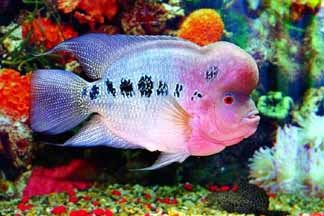
1) Hình dáng. Phần này nên dày và có hình oval. Vài biến thể của nó có dạng gần như hình tròn. Bụng đầy đặn và không có nếp gấp.
2) Màu sắc. Đa phần La Hán có màu đỏ nổi bật từ má đến vùng bụng. Tuy nhiên chúng có thêm màu nền gần như đỏ rực.
3) Vảy hạt trai. Đa phần có màu xanh với sức hấp dẫn kỳ lạ.
4) Đốm ngang màu đen. Đốm đen đậm dày nói lên sự khoẻ mạnh của cá. Tuy nhiên không phải con nào cũng được như vậy. Chúng ta nên xem xét mình cá để tham khảo.
5) Đầu. Không liên quan đến hình dáng, kích cỡ và màu sắc, đầu gù là loài cá được ưa chuộng. Nhưng nó cần được cân đối với hình dáng và kích cỡ của cá.
6) Mắt. Nằm ở vị trí hai bên đầu. Mắt tròn và mi mắt lanh lợi, dễ nhận thấy.
7) Vây và đuôi nên thường xuyên ở vị trí thẳng đứng.
Theo Flowerhornxport (phỏng dịch Nguyễn Thanh Vân vannt@hcm.vnn.vn)
Bài gốc:
Flower Horn Fish or Hua Luo Han which is popularly known has taken the aquatic world (particularly in the South East Asian region) by storm within the last two years. Its popularity is gaining momentum day by day, and it is set to be an internationally known fish with the likes of the discus fish and arowana.
Luo Han fish is basically from the Cichlid family, which is classified under the genus of Cichlasoma, a specie commonly found in South America. This beautiful hybrid is thought to be the end product of cross breeding between the Cichlasoma Trimaculatus, Cichlasoma Festae, Jingang Blood Parrot, and etc.. To date, a lot of better quality Luo Han have been produced resulting from the intensified eagerness of breeders to produce the best show quality fish for the market.
As was stated in some reports, the Flower Horn Fish is also known as a "mutated" breed of fish. Rest assured that this is just a claim. We would like to stress that the Flower Horn Fish has gone through a lot of selective cross breeding in order to have the best characteristics of the respective strains of the Cichlid fish family. For instance, most breeders are striving to produce Flower Horn fishes with bigger nuchal hump on the forehead, better coloration, bolder black markings on the body (which at times resemble Chinese characters), more elegant fins, and wider body. No chemicals, or bio-genetic engineering have been incorporated to improve on the traits / characteristics of the Flower Horn. Thus, the claim that this is a mutated fish is unfounded.
In addition, this fish is very hardy, and can endure water conditions that are not suitable for most breeds of aquarium fish. This is also one of the many reasons why the Flower Horn is well received by many tropical fish hobbyists. As the Flower Horn is from the South American Cichlid family, this fish is very territorial. Thus, they are very aggressive in nature. Co-existing with another fish is not advisable, (especially smaller fish). Some parties have claimed that we can "play" with the Flower Horn. In actual fact, the Flower Horn is actually trying to get rid of the "intruder" (be it a stick or a person's hand). Therefore, it is advisable that we keep our hands to ourselves as the fish has quite a nasty bite depending on the size of the fish.
More articles coming soon:
- Judging and Appreciating
- Disease and Prevention
- General Illness
- Breeding Behaviour and Sexing of Flower Horn Fish
- Flower Horn And Feng Shui
- Cultivating a good relationship
Theo Flowerfish
Basics of Flower Horn Fish Keeping
This article below is a basic guide on keeping flower horn fish. It has been compiled by our experienced breeders. Be aware that there may be some information which are not available. If you have further questions, please do not hesitate to contact us; click here.
Temperature
Like most tropical fish, flower horn thrives in temperature between
20-30°C. Ideal or recommended temperature will be around 28-31°C.
Water Condition
One of the important criteria in flower horn fish keeping is the pH
level of the water the it lives in. pH level is actually the measure
of acidity or alkaline of the water. The pH scales ranges from 0 to
14. Flower horn fish requires moderately alkaline water, ideally
between 7.5 to 8.0. In order to maintain stable water conditions, it
is advisable to have a regular water change interval of once a week.
It is also advisable to mix a portion of crushed coral with the
gravel. This will further maintain pH stability. Like any other
fish, sudden or drastic changes on the pH level can be detrimental
to the flower horn fish. As precaution, it will be great to check
the pH of the water periodically.
Filtration System
On the overall, flower horn fish is easily maintained. No doubt that
it is a hardy breed. But to bring out the best of the fish (be it
coloration, nuchal hump and overall health), we should incorporate
an efficient filtration system. There are quite a number of
filtration systems in the market. Ideally the filtration system
should have these criteria:
• Easily cleaned
• Efficient mechanical pre-filter
• A biological system that is protected from clogging
Last but not least, regular / periodic partial water changes is also
important.
Water Change
For some hobbyist, water change is a chore that they dreaded most.
In order to have a well maintained tank, periodic partial water
change should be done at least once a month. Be aware that clear
water with stable water pH and excellence water temperature does not
indicate that the water in the tank is clean. Besides, there is no
filtration system that is able to keep the tank 100% clean.
Furthermore, regular water change will ensure the growth and health
of the fish. Be doubly aware that regular topping up of the water in
the tank does not count as water evaporates. The waste from the fish
still stays behind.
Water Movement / Flow
Most of the time, the flow of the water in the tank is overlooked by
hobbyist. But it is vital to the health of the fish.
Below are some of the important factors:
• Alleviate the possibility of thermal layering. In other words,
uneven distribution of water temperature.
• It also helps to distribute oxygenated water in the tank.
• It prevents the formation of thin film on the water surface that
will hinder the gaseous exchange between air and water in the tank.
Salt and its Benefits
Salt at times acts like a stabilizer. But in some areas, the
dissolved salt content in the water is low, and the addition of
aquarium salt might simply make the fish feel more “at home”. It
acts like a disinfectant as it helps in killing certain parasites.
Salt also provides sodium and chloride ions that helps fish
stabilize.
Feeding
Flower horn fish has very good appetite. This hybrid can either take
live food or fish pellets. It is advisable to feed the fish several
times a day in small quantity. Ideally to have a mixture of life and
fish feed. This will make the fish healthier. Besides, the intensity
of coloration greatly depends on the diet of the fish. Excessive
feeding of color enhancer is not advisable as it may contain harmful
chemicals. Please do it in moderation.
Tank Environment
In general, it is important that we provide some furnishings for the
fish. The intent is to stabilize and make it feel more at home. All
that is required by flower horn fish is to have a thin layer of
gravel in the tank. Bare in mind that stressed fish will cause the
fish to loose its coloration, nuchal hump and may stun its growth.
Basic Traits
As flower horn fish is from the South American Cichlid family (under
the genus Cichlasoma), this fish is very aggressive and territorial
in nature. Coexisting with other fish is not advisable. Thus, if you
plan to have 2 or more fish in a tank, it is a requirement that you
have the tank partitioned. This will prevent the fish from fighting
that may lead to even death.
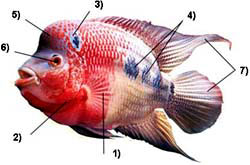
1) Body Shape
Body of the flower horn fish should be thick and oval. Some new variants being almost round. Stomach should be full and not tucked in.
2) Coloration
Most flower horn fish, red is predominant from cheek to abdominal region. However, its background colors would do well to complement the red highlighs.
3) Pearl Scales
Most recent strains has bluish / green metallic scales covering most od its body.
4) Black Horizontal Markings
It will be ideal if the flower horn fish has a strong and thick black horizontal marking on its body. However, be aware that not all flower horns has this criteria. We should look at the overall of the fish.
5) Head
Irregardless of shape, size and coloration, a good nuchal hump is preferable. It will be ideal if the nuchal hump is proportionate to the size and shape of the fish.
6) Eyes
Positioned on the sides of its head. Eyeballs and the eye linings should be alert and distinct respectively.
7) Tail & Fins
The tail and fins should stay erect most of the time.
Source: http://www.flowerhornxport.com
Việt Linh: Thông tin nông nghiệp, nuôi trồng thủy sản, nuôi trồng, kỹ thuật, chế biến, nông sản, trồng trọt, chăn nuôi, thị trường, nuôi tôm, nuôi cá, gia súc, gia cầm, việc làm, việc làm thủy sản, việc làm nông nghiệp, tuyển dụng, tìm việc, mua bán, vật tư thiết bị, môi trường, phân bón, thuốc bảo bệ thực vật, thuốc trừ sâu, thức ăn thủy sản, thức ăn chăn nuôi, cây ăn quả, cây công nghiệp, cây hoa màu, cây lương thực, cây hoa cảnh, cây thuốc, dược liệu, sinh vật cảnh, phong lan, nông thôn, nông dân, giải trí. All of aquaculture, agriculture, seafood and aquarium: technology, market, services, information and news.